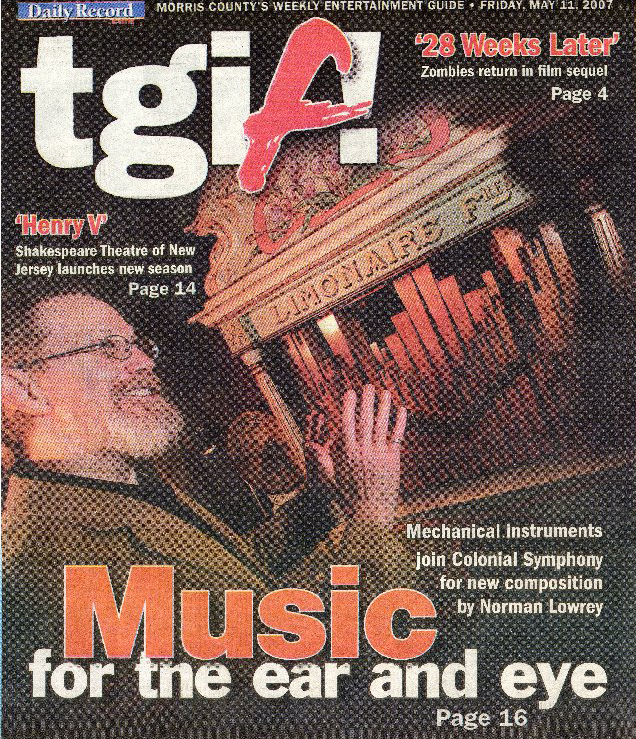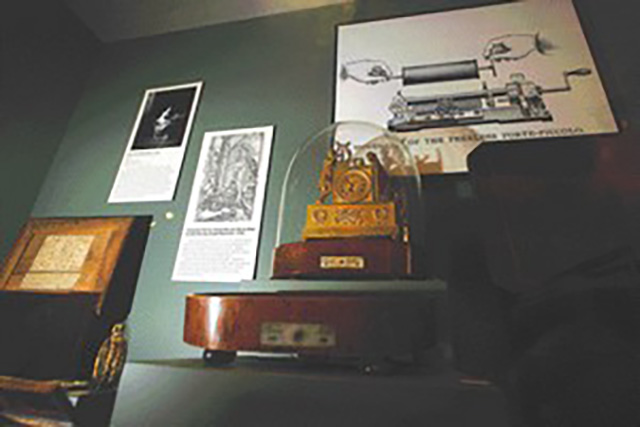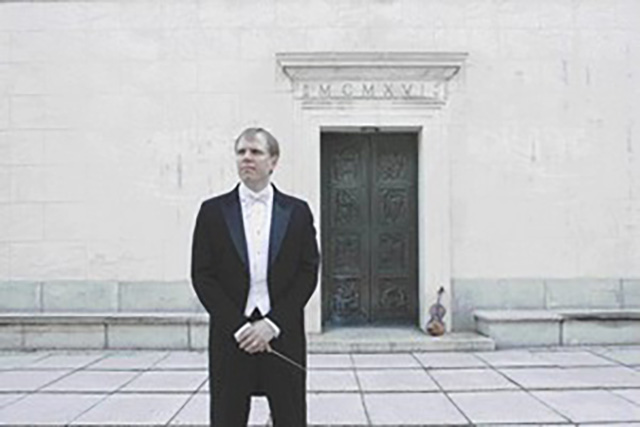Back to Soundings++
Orchestrophonia
for Mechanical Musical Instruments and Orchestraby Norman Lowrey
Program Notes
-PLAY-
Reviews:
Newark Star Ledger | Recorder Community Newspapers | Classical New Jersey
 |
 The Morris Museum's extensive collection of mechanical instruments includes many music boxes such as this one. |
 Composer Norman Lowrey and Morris Museum executive director Stephen Miller chat in front of the Orchestrophone, a mechanical instrument that is part of the museum's Guinness Collection. |
 Paul Hostetter will conduct the world premiere of 'Orchestrophonia.' |
.jpg) |
.jpg)
|
Musical past and present join hands
Colonial Symphony to perform work for orchestra and mechanical instruments
BY MIKE TSCHAPPAT
DAILY RECORD
Friday, May 11, 2007
As befits one of the stars of a new musical composition, the Orchestrophone in The Morris Museum has a gaudy exterior. Flowers adorn its front, gilt curlicues decorate the edges, and wooden organ pipes proclaim its purpose.
And when it blares out its bravura rendition of "The Sidewalks of New York," sounding a bit like a circus calliope but with pedigree, it cements its claim to stage center.
Built around 1910, the mechanical instrument will make its 21st-century concert-hall debut via film May 12 at Morristown's Community Theatre when the Colonial Symphony presents the world premiere of "Orchestrophonia," a multi-media work by Norman Lowrey, head of the music department at Drew University.
Two music boxes from the museum's Murtogh D. Guinness Collection of mechanical instruments will be on stage with the orchestra and others will be seen and heard in the movie that accompanies Lowrey's work.
Sharing the bill with "Orchestrophonia" will be Beethoven's Fifth Symphony and Wagner's "Siegfried Idyll."
The new work began as the brainchild of Colonial Symphony music director Paul Hostetter, who wanted a piece that would combine The Morris Museum's large collection of mechanical instruments with the orchestra.
"I was stunned by the diversity and complexity of the instruments, their incredible sounds," Hostetter said. "And since cultural collaborations are really at the heart of my mission with the Colonial Symphony, I thought it would be really wonderful to have a piece commissioned that incorporates both the Colonial orchestra musicians with these instruments in a live context."
Needing a composer who could wrap his mind around this novel concept, he turned to Lowrey, a master of electronic and multimedia music.
The composer, slight of build with his graying hair tied in a neat ponytail, spoke with quiet enthusiasm about the project. It was obvious that his vision of music extends well beyond the staves and notes on a sheet of paper.
Lowrey examined the vast array of instruments in the museum's collection -- 40 on display and more than 700 in all -- and realized Hostetter's plan would need to be modified.
"I readily determined that, given the fragility of the instruments and their limited availability for performance on stage, I would have to make a video," Lowrey said.
So Saturday night's audience will hear the orchestra and two music boxes live, with the film projected above the musicians and broadcast in 5.1 surround sound.
The video, born out of necessity, has evolved into an artistic statement in its own right.
"There are a lot of close-ups," Lowrey said. "There's an attempt to move into the interior of the instruments, as though trying to penetrate the mystery of the instruments."
The music boxes are ornate, many with their jewel-like mechanisms visible as they play. Some contain rolls with pins that pluck steel teeth to create the musical notes. Others are metal discs with nubs that, as they rotate, strike a steel comb to produce sound.
The Guinness Collection also includes many mechanical organs and pianos as well as automata -- figures that appear to be playing music.
Stephen Miller, executive director of the Morris Museum, explained that the pieces were collected by Murtogh D. Guinness, who lived in Manhattan. When he died in 2002, he left the collection in a trust.
His desire was that his collection would go to a museum in its entirety where it could be enjoyed by the general public," Miller said.
Various museums vied for the honor of housing the collection, and in 2003 it was awarded to The Morris Museum. The display opened in November of that year.
The current exhibit, although housed in a modestly sized room, is a treasure trove for both children and adults. The instruments are demonstrated every day except Monday and holidays when the museum is closed.
There is no exhibit like this in the Western hemisphere," Miller said.
The expansion of the museum, currently under construction and due to open later this year, will include a Guinness wing three times the size of the present space. The official opening of the new Guinness wing is the first weekend of November.
The number of mechanical instruments on display will rise to 130 with the remainder visible in what is called viewable storage, Miller said. Interactive media, including film and sound, will add to the experience.
The two music boxes on stage Saturday night each have a repertoire of a single piece -- the overture to Carl Maria von Weber's "Der Freischütz" in one case and a popular tune in the other. They will be integrated into the overall composition along with the orchestra.
"Once I had the video laid out," Lowrey said, "I then had to transcribe the music of the mechanical instruments and determine what I was going to do with the orchestra, not just as accompaniment but as a musical collaborator with the instruments."
Lowrey said all of the music played by the orchestra is derived from the tunes of the mechanical instruments.
The responsibility for keeping the various threads of the performance together falls on the shoulders of Hostetter.
"What I have to do is coordinate what I'm hearing in the film with what the musicians have to do," Hostetter said. "So I'll actually have a set of headphones on so that I can hear the mix."
Two of Hostetter's students from Montclair State University, who had seen the Guinness collection and were enthusiastic about it, will operate the two music boxes.
They're both excellent musicians and I think fully capable of operating these instruments, which means turning them on and turning them off," Hostetter said.
The conductor seems unconcerned about the possibility of something coming unplugged, a piece of equipment malfunctioning, or a spring snapping.
I've done lots of pieces with electronic media and I haven't had a bad experience so far, knock on wood," he said.
Since "Orchestrophonia" is a revolutionary idea, Hostetter believed he should include works on the program by two revolutionary composers -- Beethoven and Wagner.
The Fifth Symphony was one of those watershed pieces which is why it's had such a power over audiences for years," he said.
Both Beethoven and Wagner composed in the 19th century when music boxes and mechanical instruments made their biggest jump in technical refinement. Lowrey finds the instruments a link to that era.
"In my own experience with these mechanical instruments, it's like listening to a sonic time machine," he said. "They transport me to a different time. It's like a musical dream journey through time."
(See reviews: Newark Star Ledger, Recorder Community Newspapers, Classical New Jersey)
nlowrey@drew.edu


